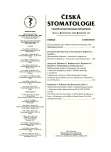Cephalometric Analysis of Teleradiographic Images in Healthy Adult Patiens from the Standpoint of Prosthetics and Orthodontic
Authors:
M. Janega 1; A. Řeháček 1; P. Hofmanová 2; T. Dostálová 2; Z. Šmahel 3; Velemínská J. Fendrychová J. 3 2
Authors‘ workplace:
Stomatologická klinika 1. LF UK a VFN, Praha
1; Dětská stomatologická klinika 2. LF UK a FN Motol, Praha
2; Katedra antropologie a genetiky člověka UK, Praha
3
Published in:
Česká stomatologie / Praktické zubní lékařství, ročník 109, 2009, 6, s. 112-116
Overview
The technique of lateral cephalometric radiography has become widely used as a descriptive, analytical, and diagnostic tool in clinical orthodontics and prosthodontics. The application of numbers to the radiographic images readily gives the impression of mathematical accuracy. The purpose of study was to established sex-specific normative data for Czech patients in Prague. The 88 subjects (55 male and 33 female) were included in the study. 20 different measurements (computer analysis Kefalo 4.07) were used as determinates of the skeletal sagital jaw relationship. The subjects were divided into groups based on gender. Differences of mean values were tested using statistical tests. The data were compared with 12 different Caucasian European and American measurements. The statistical significant difference between European standard and Czech subjects was not found. Our findings support hypothesis that cephalometric norms are based on racial, age but not sex difference. Anterior and posterior facial heights were reduced due to less sufficient therapy.
Key words:
prosthodontics - orthodontics - cephalometric x-ray
Sources
1. Ajayi, E. O.: Cephalometric norms of Nigerian children. Am. J. Orthod. Dentofacial Orthop., 128, 2005, 5, s. 653-656.
2. Anderson, A. A., Anderson, A. C., Hornbuckle, A. C.: Biological derivation of a range of cephalometric norms for children of African American descent (after Steiner). Am. J. Orthod. Dentofacial Orthop., 118, 2000, 1, s. 90-100.
3. Bailey, K. L., Taylor, R. W.: Mesh diagram cephalometric norms for Americans of Africian descent. Am. J. Orthod. Dentofacial Orthop., 114, 1998, 2, s. 218-223.
4. Bettega, G., Chenin, M., Sadek, H., Cinquin, P., Lebeau, J., Coulomb, M., Raphael, B.: Tree dimensional fetal cephalometry. Cleft Palate Craniofac., 33, 1996, 6, s. 463-467.
5. Connor, A. M., Moshiri, F.: Orthognathic surgery norms for American black patients. Am. J. Orthod., 87, 1985, 2, s. 119-134.
6. Cotton, W. N., Takano, W. S., Wong, W. M. W.: The Downs analysis applied the three other etnic groups. Angle Orthod., 21, 1951, s. 213-220.
7. Cutting, C., Bookstein, F. L., Grayson, B., Fellingham, L., McCarthy, J. G.: Three-dimensional computer-assisted design of craniofacial surgical procedures: optimization and interaction with cephalometric and CT-based models. Plastic Reconstruc. Surg., 24, 1986, s. 98-101.
8. Dandajena, T. C., Nanda, R. S.: Bialveolar protrusion in a Zimbabwean sample. Am. J. Orthod. Dentofacial Orthop., 123, 2003, 2, s. 133-137.
9. Flinn, T. R, Ambrogio, R. I., Zeichner, S. J.: Cephalometric norms for orthodontics surgery in black American adults. J. Oral Maxillofac. Surg., 47, 1989, s. 30-39.
10. Huang, W. J., Taylor, R. W.: Dasanayake APOD. Determining cephalometric norms for Caucasians and African Americans in Birmingham. Angle Orthod., 68, 1998, 6, s. 503-511.
11. Keeve, E., Girod, S., Kikinis, R., Girod, B.: Deformable modeling of facial tissue for craniofacial surgery simulation. Comp. Aid. Surg., 3, 1998, 5, s. 228-238.
12. Kuramae, M., Magnani, M. B. B. A., Nouer, D. F., Ambrosano, G. M. B., Inoue, R. C.: Analysis of Tweed’s Facial Triangle in Black Brazilian youngsters with normal occlusion. Braz. J. Oral Sci., 8, 2004, s. 401-403.
13. Lo, L. J., Marsh, J. L., Vannier, M. W., Patel, V. V.: Craniofacial computer assisted surgical planning. Clin. Plastic Surg., 21. 1994, s. 501-516.
14. Marsh, J. L., Vannier, M. W., Bresina, S., Hemmer, K. M.: Applications of computer graphics in craniofacial surgery. Clin. Plast. Surg., 13, 1986, 3, s. 441-448.
15. Moss, D. J.: Building on a strong foundation.. J. Dent. Educ., 58, 1994, 4, s. 295-297.
16. Moss, J. P., McCance, A. M., Fright, W. R., Linney, A. D., James, D. R.: A three-dimensional soft tissue analysis of fifteen patients with Class II, Division 1 malocclusions after bimaxillary surgery. Am. J. Orthod. Dentofacial Orthop., 105, 1994, 5, s. 430-437.
17. Moss, M. L., Salentijn, L.: The primary role of functional matrices in facial growth. Am. J. Orthod., 55, 1969, 4, s. 566-577.
18. Naidoo, L. C., Miles, L. P.: An evaluation of the mean cephalometric values for orthognathic surgery for black South African adults. Part 1. Hard tissue. J. Dent. Assoc. S Afr., 52, 1997, s. 495-502.
19. Udupa, J. K., Odhner, D.: Fast visualization, manipulation, and analysis of binary volumetric objects. IEEE Computer Graphics & Applications, 1991, s. 53-62.
20. Utomi, I. L.: A cephalometric study of antero-posterior skeletal jaw relationship in Nigerian Hausa-Fulani children. West Afr. J. Med., 23, 2004, 23, s. 119-222.
21. Vannier, M. W., Marsh, J. L., Tsiaras, A.: Craniofacial surgical planning and evaluation with computers. In: Taylor, R., Lavallée, S., Burdea, G., Mösges, R. (editors): Computer-integrated surgery. Cambridge, MA, MIT Press, 1996, s. 673-677.
22. Vannier, M. W., Marsh, J. L., Warren, J. O.: Three-dimensional computer graphics for craniofacial surgical planning and evaluation. Computer Graphics, 17, 1983, s. 263-274.
23. Waters, K.: Synthetic muscular contraction on facial tissue derived from computerized tomography data. In: Taylor, R., Lavallée, S., Burdea, G., Mösges, R. (editors): Computer-integrated surgery. Cambridge, MA, MIT Press, 1996, s. 191-199.
Labels
Maxillofacial surgery Orthodontics Dental medicineArticle was published in
Czech Dental Journal

2009 Issue 6
Most read in this issue
- Cephalometric Analysis of Teleradiographic Images in Healthy Adult Patiens from the Standpoint of Prosthetics and Orthodontic
- Ectodermal Dysplasia – Connections and Implantation
- The Removal of Ceramic Locks in Orthodontia by Means of Laser – Evaluation of the Effect of Diode Lasers Tm:YAP, Nd:YAG and GaAs
- Acquiring of a Paradigmatic Prosthetic Abutment by Means of Laboratory Parallelometer
